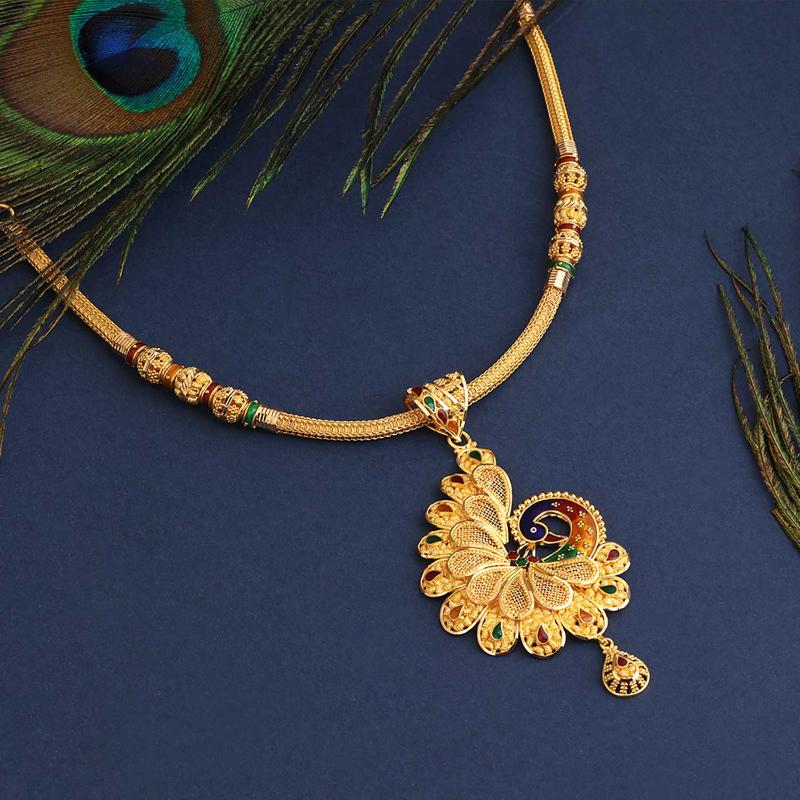Gold jewellery holds a special place in every Maharashtrian household. For generations, it has been more than just an accessory. It is a symbol of tradition, pride, and identity. Among the many cherished pieces, gold pendant designs have always stood out. From classic motifs to contemporary styles, the evolution of gold pendants in Maharashtrian jewellery reflects the changing tastes of generations while holding on to cultural roots.
A heritage shaped by tradition
Maharashtrian jewellery is known for its strong link to customs and rituals. Gold pendants have long played a central role, particularly in necklaces worn during festivals, weddings, and other significant family occasions. Traditional gold jewellery, such as the Thushi, Mohan Mala, and Putli Haar, often features intricately crafted pendants with motifs inspired by nature, deities, and royal patterns.
Earlier designs were often chunky and hand-carved, using techniques that took days to complete. Patterns such as peacocks, lotuses, the sun, and religious symbols were popular, and each pendant had a unique story behind it. These designs were not just for beauty but also carried spiritual and emotional meaning for the wearer.
From timeless classics to modern silhouettes
Over time, while the love for traditional gold jewellery remains strong, the designs have adapted to modern preferences. Today’s women want jewellery that is versatile enough to be worn beyond special occasions. This shift has inspired jewellers to reimagine gold pendant designs in ways that balance tradition and simplicity.
Modern pendant styles are now sleeker, more lightweight, and crafted with comfort in mind. While the core motifs remain the same, they are often given a minimalistic twist. A sun-shaped pendant that was once elaborate may now come in a clean-cut design with delicate engraving. Pendants with pearls or gemstones that once appeared in large sets are now available in smaller sizes, perfect for everyday wear.
Blending cultural heritage with everyday elegance
One of the biggest changes in gold pendant designs is the ability to blend with both ethnic and modern outfits. Young brides and working women alike prefer pieces that can move from a festive saree to an office kurti or a casual dress. This has made layered chains with subtle pendants increasingly popular.
Designs inspired by traditional Maharashtrian jewellery, such as the Tanmani and Kolhapuri Saaj, are being reinterpreted as standalone pendants. These versions retain their original charm but are styled for a more contemporary appeal. They serve as a connection to roots without feeling too heavy or ornate for daily wear.
Craftsmanship that keeps evolving
At Waman Hari Pethe Sons, our design philosophy has always honoured heritage while welcoming innovation. Each gold pendant is a result of fine craftsmanship, inspired by the aesthetics of traditional gold jewellery and designed to suit modern sensibilities. Whether it is a dainty floral piece or a pendant inspired by temple art, our collections bring together the best of both worlds.
We continue to create pendant designs that resonate with every generation. Some may choose detailed filigree pendants for festive occasions, while others may prefer plain gold designs with a hint of texture for everyday elegance.
Jewellery that tells your story
The evolution of gold pendant designs is a reflection of how Maharashtrian jewellery has adapted with time. It is no longer limited to the showcase or locker. It has become a part of daily life, of personal expression, and of staying connected to one’s roots in a modern way.
As trends change, what remains constant is the emotional value that traditional gold jewellery carries. Whether you are rediscovering your heritage or starting your collection, gold pendants from Waman Hari Pethe Sons are crafted to be timeless companions that grow with you.


